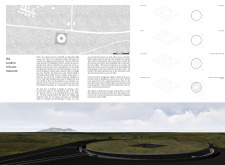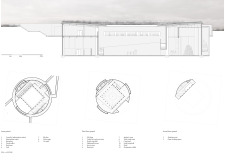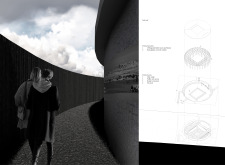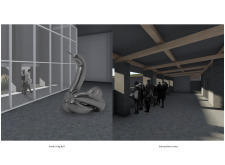5 key facts about this project
The Sunken Volcano Museum in Reykjahlíð, Iceland, is designed to connect visitors with the stunning landscape surrounding the famous Hverfjall volcano. The museum aims to educate the public about the region's natural history and cultural significance. Its design concept integrates architecture with the landscape, using a sunken form that reduces visual impact and blends with the natural topography.
Design Concept
The approach to the museum’s design is informed by the volcano’s height and crater. A circular layout allows for easy movement, creating an inviting atmosphere for visitors. By embedding the building into the land, the architects wanted to ensure that it feels like part of the geography rather than an imposition upon it. The overall design promotes a feeling of openness and connection with the surroundings.
Spatial Organization
Inside the museum, spaces are thoughtfully arranged to serve both public and private functions. Key areas such as the cafe, information center, and operational offices are located on the first lower ground floor. Visitors access the exhibition areas on the third lower level via a ramp. This layout ensures that pathways are clear, allowing for a smooth flow of movement from one area to another, enhancing the visitor experience.
Architectural Integration
A distinct feature of the museum is its turf roof. This traditional Icelandic building method offers insulation while allowing the structure to blend into the landscape. It also reflects the cultural practices of the region, emphasizing a design that respects local heritage and the environment. The choice of this roofing technique demonstrates a commitment to sustainability while paying homage to traditional architecture.
Material Palette
The materials used in the museum are inspired by the natural geology of the area, particularly the dark tones found in Hverfjall and similar formations. This choice creates a cohesive appearance that aligns with the surrounding landscape. By selecting materials that resonate with the site, the museum's design highlights the interplay between built and natural environments.
Inside the museum, spaces are crafted to create a calm atmosphere where visitors can engage with the artistic and cultural exhibits. Attention to detail in the layout and design ensures that the building serves its educational purpose while fostering a deep connection to the landscape in which it resides.





















































